Drying Room Heaters: Building Drying Top 10 Tips
Looking to browse drying room heaters? Just click here to be taken to our Heating range or call 01729 824108.
Your essential guide to drying rooms and buildings after a flood disaster.
The rain lashes down, drains block with fallen leaves and silt. The flood waters rise and search for new destinations. Houses, businesses, shops, offices, schools - the flood water does not discriminate between building types, only what 'level' they are at. Although these days flooding can arise at any time of year it is still a particular problem in autumn. Buildings affected can be anything from a bit damp to massively damaged by flood water.
Here, we provide our top tips for drying out buildings and rooms affected by flooding. These top tips are as useful for drying up after a burst pipe, or bath overflow as they are for a rainwater flood, and should help you get dry in quick time.
1. If insured, discuss your claim and drying requirements with your insurer
They may hire a contractor to do the drying for you, in which case you can concentrate your attention on saving your contents and making sure that those you are responsible for are accommodated somewhere else.
If it is a small drying job, perhaps one that is uninsured, or one that is not worth claiming for then the next 9 top tips are good to go, so long as you can establish that it is safe to do so by first consulting an electrician and perhaps a plumber.
2. What's wet?
No, it's not a stupid question but the answer will affect how you dry the building and what equipment you use.
Say you have a traditional British type constructed building and the masonry walls and the suspended floor, complete with carpets is wet, then what you are looking at is potentially using a puddle pump (to pump out any remaining flood water from under your floor), a carpet dryer fan to blow air under the carpet, dehumidifier and a radiant heater.
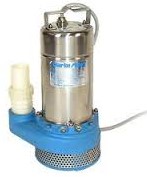
Puddle pump - Good for pumping out flood water from under suspended floors
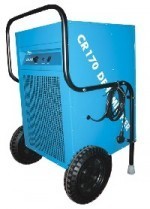
Big building dryer, otherwise known as an industrial mobile dehumidifier
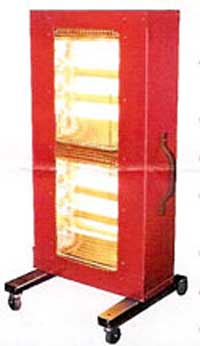
Mobile radiant heater ideal for warming walls
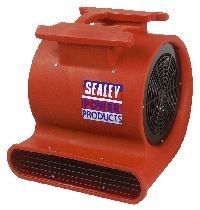
Carpet dryer designed for blowing air under a carpet so that the air gets a chance to dry the floor underneath and underside of the carpet
Alternatively - If you have a modern solid floor with tiles, timber or laminate flooring, then the chances are that it has been laid with an insulation layer which is saturated and needs to be dried before it can again be an effective insulating layer. For this you will need a restorative drying unit (to suck water out from the insulation layer under the floor), a dehumidifier and a radiant heater.
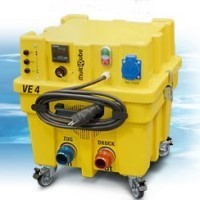
Restorative dryer, designed to dry out insulation layers under floors and in other difficult places

Big building drying room heater, otherwise known as an industrial mobile dehumidifier

Mobile radiant heater ideal for drying room walls
3. Use as big a drying room heater (humidifier) as you can afford
Basically a little domestic plastic cased machine will not be up to it. You will need a big mobile dehumidifier - consider 30 ltr/day extraction rate as the bare minimum for drying a flood damaged small room.
Bigger is better and quicker. More than one room to dry ? Then consider using extra dehumidifiers.
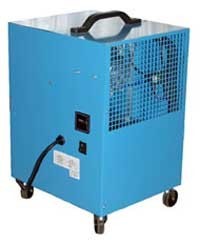
With only about 11 or 12 ltr/day removal rate @ 20 °C, it will take a long time, but is better than nothing
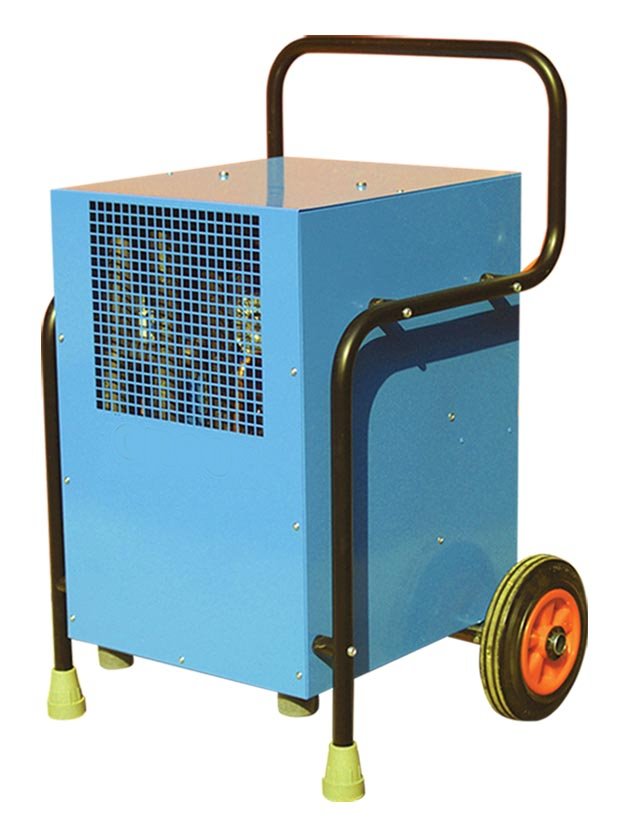
A bit bigger and a bit better

Bigger yet, even better and quicker
4. When using a dehumidifier make sure to minimise air ingress into the building
Close all doors and windows and trickle vents (if you have them). The idea here is that by keeping the building air sealed, that the air in the building can be made as dry as possible with the dehumidifier, without giving it the extra burden of drying extra air from outside.
5. Ensure the dehumidifier is positioned so that it can treat the air without any obstructions
Placement in the middle of the room is best. If you have a large room and a number of dehumidifiers working simultaneously, spread them evenly in the room and away from walls.
6. Use portable radiant drying room heaters for heating up surfaces, such as plaster work
Warm walls will evaporate water far quicker than cold walls. Either use conventional portable radiant heaters or use radiant masonry drying panels. Don't put them too close to the wall otherwise you will get a hot spot, but place them a distance away so that a greater area is gently warmed.
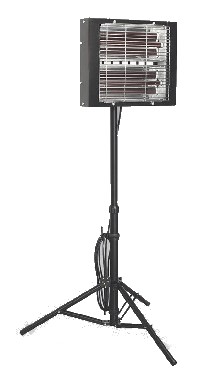
Set back from a wall it will provide heat to a large area of wall to speed drying
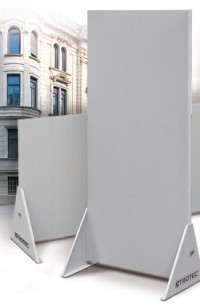
Masonry dryers are ideal for drying plaster and for drying out walls after flooding
7. Add extra heat
Radiant heaters when used will also (in time) warm up air in the building, but if it is still cold in the room or building put in electric space heaters to raise the air temperature.
Don't use direct fired oil or gas fired heaters for this purpose as they will deplete the oxygen in the building. If you need more heating power, beyond what the mains supply to the building can safely provide via electric heaters, then use indirect fired oil or gas heating, with the heater located outside and warm air ducted in, ideally on a recirculation system so that heat is not wasted to the outside.
Ideally the building air temperature needs to be raised to at least 20°C. The warmer the air is the more moisture it can hold, the more water will evaporate from surfaces, and the more efficiently the dehumidifier(s) will work.
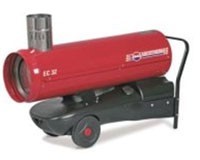
Arcotherm EC32 indirect oil-fired heater can deliver about 29kw of heat to a building. This model can not be fitted with a recirculation duct
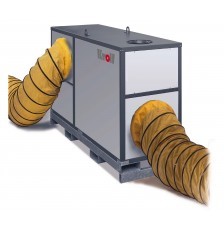
Kroll HM200 indirect gas-fired heating plant for large heating and drying jobs. This model is fitted with a recirculation duct
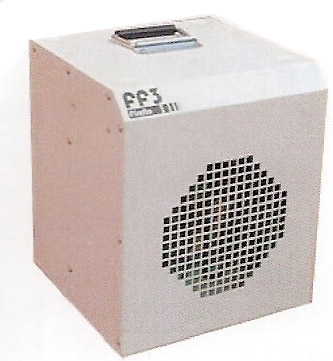
FireFlo FF3 portable fan heater, ideal for putting extra heat into a room that is being dried
8. Work out what happens with the condensate collected by the dehumidifier
If it collects in a tank, remember to frequently empty the tank. If you do not do this the dehumidifier will stop to prevent it spilling the condensate on to the floor.
If it has a continuous drainage arrangement make sure that it can flow by gravity to a suitable drain. If the dehumidifier has a condensate drain that is great, because it means that you can get the condensate to a drain more or less anywhere within reach of the hose that you attach to the dehumidifier and means you can leave the machine to work for long periods.
If necessary slightly elevate the dehumidifier on blocks of some sort so that the gravity drain will operate successfully.
9. Consider putting air circulator fans into the building
If there is not enough air movement from the various machines in the building, the dehumidifiers, heaters, carpet dryers etc., you may discover that some areas are holding air pockets which are being left by the general air circulation. In this situation use fans to move the air in these areas.
10. Use a moisture meter to track drying progress
With active drying there is a danger that walls and floors appear to be dry when they are still damp under the surface. 2 pin or 4 pin moisture meters can be purchased for as little as £10 and they tell you what is happening in the wall rather than what is happening on the surface. If you don't get this right, you might think your building is dry and as soon as you remove the dehumidifiers and drop the heat to normal levels, damp will reappear. Also use feel to determine how the building is drying. Drying of walls will start at the top of the wall and dry towards the base. As you run your hand over what appears to be a dry wall, top to bottom you will probably notice the temperature of the wall cool, part way down. This will be roughly where the wall has dried down to.
These Building Drying Top 10 Tips are designed to give a brief overview of the challenge drying a building or perhaps a room.
The Guidance and standards for drying flood damaged buildings provides a really comprehensive guide to the subject and has much more information.
For more information or want to hear from one of our specialists, visit our website for further details.
